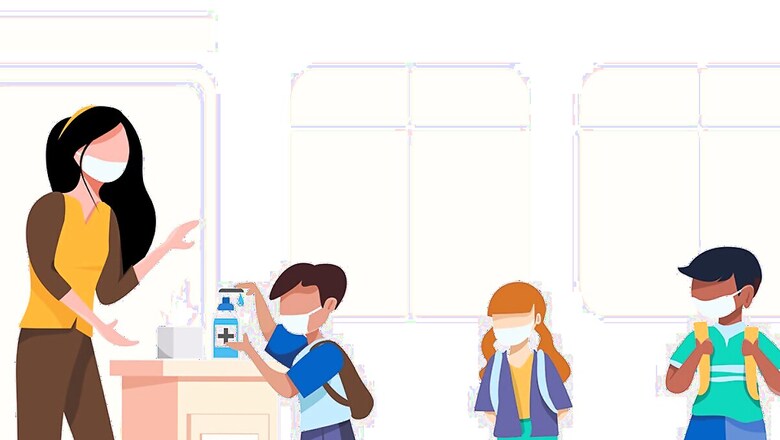
views
Each year, we lose 525,000 children under the age of five to diarrhoea, worldwide. Diarrhoea is also the leading cause of malnutrition in children in the same age group. One of the easiest ways to prevent diarrhoeal infections is teaching children toilet hygiene. Aside from diarrhoea, poor toilet hygiene can also cause a number of other avoidable infections.
Children who know that they must wash their hands after using the toilet and know how to clean themselves properly fall ill less often. Children who understand how to keep the toilet clean by flushing properly each time and by disposing wastes the right way, also help keep their families and friends safer. A class full of children who understand the ins and outs of toilet hygiene end up with fewer infections, fewer sick days, and therefore, better results in school.
Now, as any parent knows, children need to be taught about hygiene – it isn’t instinctual. Of course, the first place where children learn toilet hygiene is at home. However, it is too important a topic to only be taught at home. Schools need to do their part too. Particularly in India, where the shift to using indoor toilets is still so fresh, and many parents don’t know enough to pass on the right habits and practices.
However, toilet hygiene education is not a common or mandatory part of the school curriculum in many countries. In India, the Sub-Group of Chief Ministers on Swachh Bharat Mission has recommended toilet hygiene and sanitation curriculum at school, college and postgraduate levels, but implementation is still underway.
Benefits of School Initiatives on Toilet Hygiene
A good toilet hygiene curriculum can:
- Give students accurate and relevant information about toilet hygiene, its benefits and consequences, and how to practise it effectively.
- Empower students to make informed decisions and take action regarding their toilet hygiene, such as choosing appropriate products, using them correctly, disposing of them safely, and maintaining personal and environmental cleanliness.
- Enhance students’ attitudes and values towards toilet hygiene and encourage them to keep toilets clean for themselves and others.
- Create a supportive and enabling environment in schools, by ensuring that toilets are well constructed, well stocked, and on a reasonable cleaning schedule.
- Engage students’ families and communities in toilet hygiene education, by involving them in toilet hygiene programs in schools.
They can also help keep safe from a number of common infections, which, once present in a school’s population, can easily spread amongst children.
- Diarrhoea: One of the main causes of diarrhoea is poor toilet hygiene, especially when children do not wash their hands properly after using the toilet or before eating.
- Urinary tract infections (UTIs): UTIs are more common in girls than boys, and can be prevented by wiping from front to back after using the toilet, drinking plenty of water, and avoiding holding urine for too long.
- Pinworms: Pinworms can be spread by scratching the infected area and then touching other objects or people. Pinworms can be prevented by washing hands thoroughly after using the toilet or changing diapers, keeping fingernails short and clean, and washing bedding and clothing regularly.
- Hepatitis A: Hepatitis A can be spread by contact with faecal matter from an infected person and can easily be prevented by washing hands with soap and water after using the toilet, avoiding sharing food or utensils with others, and getting vaccinated.
In particular, a good toilet hygiene curriculum helps girls. As children are able to keep their toilet clean, girls, especially when they begin to menstruate, have a clean place to take care of their menstrual needs. By ensuring that toilets are kept clean and accessible, schools can help girls manage their menstrual hygiene with dignity and confidence, and reduce the barriers to their education and empowerment.
Toilet hygiene is not only a matter of personal health, but also of social responsibility and respect. Children who learn to keep the toilets clean and tidy, to conserve water and resources, and to dispose of waste properly, are more likely to develop a sense of civic duty and environmental awareness.
Children as Ambassadors of Change
As the Sub-Group of Chief Ministers on Swachh Bharat Mission has observed, children are formidable agents of change. Once educated about toilet hygiene and its links to disease, by and large, children tend to campaign for good toilet hygiene and toilet access within their families.
Harpic, India’s leading brand in the lavatory care segment, understands this and through its partnership in Mission Swachhta aur Paani with News18, has aimed several outreach programs at children at the preschool and school level. Mission Swachhta aur Paani is a movement that champions the cause of inclusive sanitation, equality for all genders, abilities, castes and classes and the strong belief that clean toilets are a shared responsibility.
Under the aegis of Mission Swachhta aur Paani, Harpic partnered with Sesame Workshop India, an educational non-profit, to promote positive sanitation, hygiene knowledge and behaviours among children and families through schools and communities, engaging with 17.5 million children across India. Very recently, the partnership also resulted in the new Sanitation for Good Health curriculum aimed at children at the preschool level.
As anyone who has suffered the indignity of having to use a dirty toilet knows, it takes just one person to mess up a toilet. In a country where toilets are still such a new idea, school programs are the way in which we can bring everyone together on the same page. When we all know and understand the whys and hows of toilet usage, we can all keep each other safe.
Learn how you can be a part of the solution, and help propel us towards a Swasth and Swachh Bharat.




















Comments
0 comment